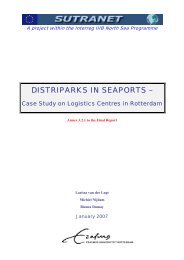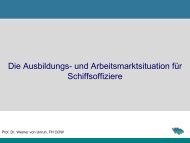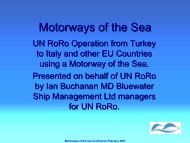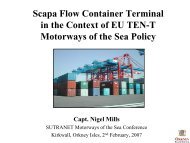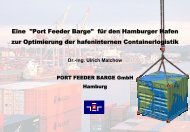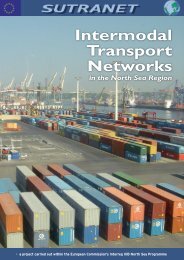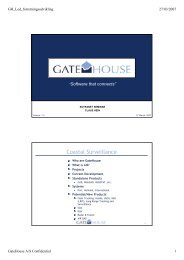TRANSPORT SYSTEMS CONCEPTS and DEFINITIONS - Sutranet
TRANSPORT SYSTEMS CONCEPTS and DEFINITIONS - Sutranet
TRANSPORT SYSTEMS CONCEPTS and DEFINITIONS - Sutranet
You also want an ePaper? Increase the reach of your titles
YUMPU automatically turns print PDFs into web optimized ePapers that Google loves.
A project within the Interreg IIIB North Sea Programme<br />
<strong>TRANSPORT</strong> <strong>SYSTEMS</strong> <strong>CONCEPTS</strong><br />
<strong>and</strong><br />
<strong>DEFINITIONS</strong><br />
Annex 1.2.1 to the Final Report<br />
June 2005/2007
PREFACE<br />
This paper has been written as part of the SUTRANET project (Work Package 1: Transport<br />
Research <strong>and</strong> Development Network). SUTRANET (‘Sustainable Transport Research &<br />
Development Network in the North Sea Region’) is a project within the framework of the<br />
European Commission’s (EC’s) Interreg IIIB North Sea Programme.<br />
The aim of the paper has been to facilitate a consistent terminology throughout the written<br />
contributions of the SUTRANET project. The paper presents a description of transport<br />
systems concepts <strong>and</strong> definitions, with a particular focus on intermodal transport in the North<br />
Sea Region (NSR). The first section presents a list of transport concept definitions. The<br />
following sections discuss the ‘North Sea Motorway’ concept, present an overview of seaports<br />
in the North Sea Region (NSR), <strong>and</strong> suggest some criteria that could be applied for the<br />
selection of seaports in the NSR to be included in the SUTRANET project research <strong>and</strong> case<br />
studies.<br />
The paper has been elaborated by a team of researchers at Aalborg University, Department of<br />
Development <strong>and</strong> Planning. It has benefited from useful comments <strong>and</strong> contributions received<br />
from other SUTRANET partners, notably Napier University, FHK, Erasmus University,<br />
SINTEF <strong>and</strong> TØI.<br />
Aalborg University, Department of Development <strong>and</strong> Planning<br />
June 2005<br />
Jørgen Kristiansen<br />
Hans Henrik W. Johannsen<br />
Some updating, corrections <strong>and</strong> editorial modifications have been added in June 2007.<br />
Jørgen Kristiansen, Aalborg University, Denmark<br />
i
Acronyms used in the Paper<br />
EC European Commission<br />
EDI Electronic Data Interchange<br />
EU European Union<br />
FP4 EC Fourth Framework Programme for Research <strong>and</strong> Development<br />
IT Information Technology<br />
LoLo Lift On/Lift Off (e.g. of containers)<br />
MoS Motorways of the Sea<br />
NSR North Sea Region<br />
NTN Nordic Transport political Network<br />
NVF Nordisk Vejteknisk Forbund (Nordic Road Association)<br />
R&D Research <strong>and</strong> Development<br />
RoRo Roll On/Roll Off (e.g. of trailers)<br />
SCM Supply Chain Management<br />
SME Small <strong>and</strong> Medium-sized Enterprise<br />
SSS Short Sea Shipping (short sea shipping)<br />
TEN-T Trans-European Transport Network<br />
TEU Twenty-foot Equivalent Unit (a st<strong>and</strong>ard unit equal to one 20 ft long container)<br />
UK United Kingdom<br />
WP Work Package (SUTRANET)<br />
ii
TABLE OF CONTENTS<br />
Page<br />
1. Transport Concept Definitions…………………………………………………... 1<br />
Multimodality…………………………………………………………………….... 1<br />
Intermodality………………………………………………………………………. 1<br />
Transport Chains…………………………………………………………………… 2<br />
Supply Chain Management………………………………………………………… 2<br />
Transport Corridors………………………………………………………………… 3<br />
Transport <strong>and</strong> Logistics Centres…………………………………………………… 4<br />
RoRo <strong>and</strong> RoPax Vessels…………………………………………………………... 6<br />
Ferry Transport…………………………………………………………………….. 6<br />
Freight Transport Units…………………………………………………………….. 6<br />
Short Sea Shipping…………………………………………………………………. 7<br />
Motorways of the Sea………………………………………………………………. 7<br />
2. Motorways of the North Sea……………………………………………………... 9<br />
3. Seaports in the North Sea Region………………………………………………... 10<br />
Categories of Seaports……………………………………………………………... 10<br />
North Sea Ports in Norway………………………………………………………… 11<br />
North Sea Ports in Western Sweden……………………………………………….. 12<br />
North Sea Ports in Jutl<strong>and</strong>………………………………………………………….. 12<br />
North Sea Ports in the UK…………………………………………………………. 13<br />
North Sea Ports in Belgium, the Netherl<strong>and</strong>s <strong>and</strong> Northern Germany…………….. 14<br />
Overview of Seaports in the North Sea Region……………………………………. 15<br />
4. Criteria for the Selection of NSR Seaports……………………………………… 17<br />
References ……………………………………………………………………………….. 18<br />
iii
1. <strong>TRANSPORT</strong> CONCEPT <strong>DEFINITIONS</strong><br />
The concepts to be described <strong>and</strong> defined in this section are:<br />
‣ Multimodality;<br />
‣ Intermodality;<br />
‣ Transport chains;<br />
‣ Supply Chain Management (SCM);<br />
‣ Transport corridors;<br />
‣ Transport <strong>and</strong> logistic centres;<br />
‣ RoPax vessels etc.;<br />
‣ Ferry transport;<br />
‣ Freight Transport Units;<br />
‣ Short sea shipping (SSS);<br />
‣ Motorways of the sea.<br />
Multimodality<br />
Multimodality implies that there is more than one modal option on a particular route or in a<br />
particular transport corridor. This implies that there is a choice between at least two<br />
different modes of transport (e.g. between road <strong>and</strong> rail, or between road/rail <strong>and</strong> ferry<br />
transport/short sea shipping).<br />
Intermodality<br />
The Commission in COM(97) 243 final document suggests the following definition:<br />
Intermodality is a characteristic of a transport system that allows at least two<br />
different modes to be used in an integrated manner in a door-to-door transport<br />
chain.<br />
Intermodal transport indicates that at least two different modes (e.g. road <strong>and</strong> rail, road <strong>and</strong><br />
ferry transport/short sea shipping, or rail <strong>and</strong> ferry transport/short sea shipping) are involved in<br />
constituting a door-to-door transport chain for individual freight shipments or passenger<br />
services.<br />
In 1999, the TRILOG Research <strong>and</strong> Development (R&D) project under the EC Fourth<br />
Framework Programme for R&D (FP4) presented the definition of intermodal freight<br />
transport (‘freight intermodalism’) as follows:<br />
The optimal integration of different transport modes, enabling an efficient <strong>and</strong><br />
cost-effective use of the transport system through seamless, customer-oriented<br />
door-to-door services, whilst favouring competition between transport operators.<br />
1
Passenger transport, at various levels, differs from freight transport in terms of institutional<br />
setting, organisation <strong>and</strong> technology. Nevertheless, the above mentioned definition could be<br />
applied as well to intermodal transport systems that are primarily concerned with passenger<br />
services.<br />
Transport Chains<br />
The INFOSTAT project (R&D project under FP4) has defined a transport chain as:<br />
A sequence of transport modes used to carry a certain quantity of goods from its<br />
origin to its final destination. Along the chain, one or more transhipments may<br />
take place.<br />
It is important to note, that a similar definition could be applied to passenger transport<br />
systems.<br />
Supply Chain Management<br />
The Supply Chain Management (SCM) concept is related with the transport chains. SCM<br />
could be described as “A management philosophy that seeks to integrate business processes<br />
in the supply chain from point of origin to point of consumption in order to meet customers’<br />
requirements… The perspective is the supply chain as a whole, not the individual companies<br />
or entities in the supply chain” 1 .<br />
Several similar definitions have been suggested 2 , e.g.:<br />
- “Supply chain management covers the flow of goods from supplier through<br />
manufacturing <strong>and</strong> distribution chain to end-user”.<br />
- “An integrative approach to dealing with the planning <strong>and</strong> control of total materials<br />
flows from suppliers through end-users”.<br />
- “The supply chain encompasses all activities associated with the flow <strong>and</strong><br />
transformation of goods from the raw materials stage (extraction), through to the enduser,<br />
as well as associated information flows. Material <strong>and</strong> information flow both up<br />
<strong>and</strong> down the supply chain. Supply chain management is the integration of these<br />
activities through improved supply chain relationships to achieve sustainable<br />
competitive advantage”.<br />
It has been stated (in the case of the Baltic Sea Region) that SCM could be viewed as a<br />
facilitator of regional development through establishing closer <strong>and</strong> long-term relationships<br />
between companies within <strong>and</strong> outside the region, by enhancing co-operation between<br />
1 Source: Slides presented by the Sc<strong>and</strong>lines’ CEO at the conference ‘Towards an integrated transport market in<br />
the Northern Dimension area by 2010’ (in Billund, Denmark, November 2002).<br />
2 From a sample of definitions of supply chain management presented in the book: ‘Underst<strong>and</strong>ing Supply<br />
Chains – Concepts, Critiques <strong>and</strong> Futures’ (Oxford University Press, 2004).<br />
2
transport services <strong>and</strong> infrastructure entities in the region, <strong>and</strong> by stimulating the development<br />
of small <strong>and</strong> medium-sized enterprises (SMEs) to create new industrial capacity in the region.<br />
Transport Corridors<br />
There is no commonly agreed definition of a transport corridor.<br />
The NVF Dictionary, version 2 (Nordic Road Association, Technical Committee No. 53,<br />
September 2002) describes a transport corridor as “A set of essentially parallel transport<br />
facilities offering alternative mode choices between two points”.<br />
Another project within the Interreg IIIB North Sea Programme, the ‘Nordic Transport political<br />
Network’ (NTN Phase II), is actually organised around a geographically defined transport<br />
corridor, i.e. ‘the NTN corridor’. The NTN project has issued a publication 3 that presents the<br />
challenges <strong>and</strong> some definitions applied to the NTN corridor. In this publication a transport<br />
corridor is briefly <strong>and</strong> simply defined as “All resources for transport of goods (<strong>and</strong><br />
passengers) between two geographical areas”. The particular corridor in focus of the NTN<br />
project “…covers the transport systems in southwestern Norway, western Sweden, western<br />
Denmark <strong>and</strong> Schleswig-Holstein. The NTN corridor embraces the resources that can secure<br />
efficient freight transport between the regions in the corridor <strong>and</strong> Central <strong>and</strong> Eastern<br />
Europe”. The corridor concept in this case is confined to the resources, facilities <strong>and</strong> services<br />
that are available to ensure efficient freight transport within the corridor, <strong>and</strong> the external<br />
connections. Geographically it is identical to the scope of the ‘Nordic Link’ corridor (see<br />
below).<br />
So far the focus in relation to transport corridors has been on freight transport. It may be<br />
considered to include the mobility aspects as well, such as high-speed ferry services <strong>and</strong> the<br />
function of regional airports as ‘gateways’.<br />
A distinction is often made between an ‘economic’ corridor <strong>and</strong> a ‘transport’ corridor. In the<br />
perspective of the North Sea Region <strong>and</strong> SUTRANET, a transport corridor is conceivably to<br />
be linked with socio-economic activities <strong>and</strong> to be broadly defined as a geographical<br />
sequence of strongly interconnected sub-regions (sources: the INFOSTAT <strong>and</strong><br />
MESUDEMO R&D projects under FP4). The MESUDEMO project advised that it is crucial<br />
also to identify the economic corridors that constitute the sources (origins <strong>and</strong> destinations) of<br />
the traffic that flows through the particular transport corridor.<br />
The transport corridor definition is closely related the functional region concept (see the<br />
SUTRANET Paper: ‘Regional Development Perspectives <strong>and</strong> Concepts in the North Sea<br />
Region’). A transport corridor represents an important structure to serve <strong>and</strong> strengthen the<br />
functional characteristics of a region, as well as the corridor could provide important<br />
interconnections <strong>and</strong> communication between two or more separate functional regions.<br />
3 NTN, November 2003: Transport corridors. Facts <strong>and</strong> development trends.<br />
3
Two examples of transport corridor concepts that have been presented related with Jutl<strong>and</strong> are<br />
the ‘Nordic Link’ <strong>and</strong> ‘West link’. Nordic Link is defined to include transport of freight <strong>and</strong><br />
related services in a geographical corridor covering Hamburg <strong>and</strong> Schleswig-Holstein,<br />
Jutl<strong>and</strong>, western Sweden (including Gothenburg) <strong>and</strong> southern Norway (including Oslo). The<br />
Nordic Link corridor has been promoted by a number of transport companies, including ferry<br />
operators, in the corridor. The Westlink corridor takes the point of departure from the Port of<br />
Hanstholm in north-western Jutl<strong>and</strong>. It is initiated by local governments in western Norway<br />
<strong>and</strong> around the Hanstholm port. The stated aim of Westlink is to enhance co-operation<br />
between ports <strong>and</strong> commercial companies in the areas around the North Sea, particularly<br />
Hanstholm, western Norway, eastern UK <strong>and</strong> the North Atlantic.<br />
The transport corridor concept is applied also in the SUTRANET project’s description of<br />
‘Unitised Goods Transport Scenarios in the North Sea Region’.<br />
Transport <strong>and</strong> Logistics Centres<br />
A transport <strong>and</strong> logistics centre is a centre h<strong>and</strong>ling transport with a view to the logistic<br />
requirements. In this relation it is relevant to repeat the definition of a ‘logistic family’<br />
(quoted from: Freight Transport Statistics – Statistical sources <strong>and</strong> requirements for freight<br />
transport modelling. ISP Series No. 264. Department of Development <strong>and</strong> Planning, Aalborg<br />
University. December 2000):<br />
A logistic family is a grouping or classification of commodities, with a view to<br />
how they are being h<strong>and</strong>led <strong>and</strong> transported from a logistical point of view.<br />
Thus they are featuring similar logistical requirements that are more closely<br />
related to manufacturing <strong>and</strong> commercial behaviour, ref. economies of scope.<br />
A SUTRANET Work Package 3 report 4 describes a transport centre as a commercial area<br />
offering a location in connection with the physical infrastructure that is attractive to transport<br />
operators. Thus a transport centre could be a node in a transport network but this is not<br />
always the case. The report presents the following definition of a logistics centre:<br />
A defined area within which all activities relating to transport, logistics <strong>and</strong> the<br />
distribution of goods – both for national <strong>and</strong> international transit - are carried<br />
out by various operators on a commercial basis.<br />
In this sense a logistics centre could be characterised as a semi-infrastructure facility. It is<br />
both commercial (established <strong>and</strong> managed by a neutral legal body, preferably by a Public-<br />
Private-Partnership arrangement) <strong>and</strong> a facility that must be open to allow access to all<br />
competing companies <strong>and</strong> operators. The report advises that a logistics centre, in order to<br />
encourage intermodal transport, should preferably be served by a multiplicity of transport<br />
modes (road, rail, short sea or deep sea shipping, inl<strong>and</strong> waterway, aviation).<br />
4 SUTRANET, 2007: Analysis of Institutional <strong>and</strong> Organisational Solutions in the Development of Transport &<br />
Logistics Centres.<br />
4
Transport <strong>and</strong> logistics centres are normally specified according to their place in a network<br />
hierarchy, but several definitions have been suggested. A recent Danish study report 5 suggests<br />
the following hierarchal classification of transport centres:<br />
a. National centre of particular European importance;<br />
b. National centre of some European importance;<br />
c. National centre of regional (within the country) importance;<br />
d. Regional centre (within the country);<br />
e. Area centre of local importance.<br />
This classification could be modified <strong>and</strong> simplified with a view to the trans-national context<br />
<strong>and</strong> North Sea Region perspective <strong>and</strong> involve:<br />
I. TEN-T centres;<br />
II. North Sea Region (NSR) centres;<br />
III. National/local centres.<br />
Class I centres are located in one of the transport corridors served by the Trans-European<br />
Transport Network (TEN-T). They offer h<strong>and</strong>ling of more than one mode of transport<br />
(‘multimodality’), <strong>and</strong> an integrated co-operation with a range of other European transport<br />
centres about routing <strong>and</strong> EDI/IT etc.<br />
Class II centres are located in a major transport corridor in the NSR, but a corridor not<br />
necessarily included in the TEN-T. Class B centres are part of a transport network that<br />
provides access to areas outside the NSR via the TEN-T. They should also provide a certain<br />
degree of ‘intermodality’ <strong>and</strong> serve European <strong>and</strong> international traffic to some extent.<br />
The Class III category includes centres of mainly national or local influence. Some of these<br />
centres may have a potentially favourable location, <strong>and</strong> could develop to be of eventual<br />
importance to the overall connectivity <strong>and</strong> functioning of transnational networks within the<br />
NSR, such as providing transhipment between short sea shipping <strong>and</strong> the hinterl<strong>and</strong><br />
connections.<br />
In the SUTRANET context, the transport <strong>and</strong> logistical centres under analysis should be<br />
functioning as important nodes or transhipment points in the NSR transport network <strong>and</strong><br />
systems. This implies that the transport <strong>and</strong> logistic centres will most probably be located in a<br />
seaport provided with h<strong>and</strong>ling facilities for ferries, container ships <strong>and</strong>/or RoRo ships or<br />
similar types of unit load ships. The centre should be served by both road <strong>and</strong> rail<br />
infrastructure facilities <strong>and</strong> connections on the l<strong>and</strong> side. The transport <strong>and</strong> logistics centre<br />
will, however, only be a part of a seaport that constitutes a node in the NSR transport network.<br />
5 Ministry of Environment, December 2002 (in Danish): Transport i det kompetente og innovative Danmark.<br />
5
RoRo <strong>and</strong> RoPax Vessels<br />
The ‘RoPax’ concept is related with RoRo (roll on/roll off) vessels 6 . A RoRo vessel typically<br />
carries a mixture of rolling cargo dominated by road trailers (lorries <strong>and</strong> unaccompanied semitrailers),<br />
but also containers loaded on special rilling equipment. The RoRo vessel is mainly<br />
considered as a freight ship. The term ‘RoPax’ indicates that a RoPax vessel is able to serve<br />
both passengers <strong>and</strong> freight on vehicles/trailers. It is combining the cargo capacity of a RoRo<br />
vessel with the passenger amenities of a modern ferry.<br />
Ferry Transport<br />
Ferry services could include both passengers <strong>and</strong> freight. The services are scheduled i.e. they<br />
take place according to a regular time table <strong>and</strong> are often relatively frequent.<br />
In order to qualify as a ferry route, the maritime link in question must connect overl<strong>and</strong> road<br />
<strong>and</strong>/or rail infrastructure at both ends of the route. Thus the ferry route is mainly one link only<br />
in a passenger trip or freight transport chain consisting of roads <strong>and</strong>/or railway connections at<br />
both ends.<br />
Some types of ferries (e.g. cruise ferries) serve passengers only (unaccompanied, by bus or by<br />
passenger cars), Most of the current ferry services in the NSR provide for combined<br />
passenger <strong>and</strong> freight transport onboard the same vessel (i.e. a RoPax vessel). Ferry services<br />
also appear in the form of RoRo vessels that serve goods only (lorries, unaccompanied semitrailers,<br />
railway wagons).<br />
Freight Transport Units<br />
Some relevant terms for unit loads are:<br />
TEU (or teu).<br />
A ‘TEU’ means a st<strong>and</strong>ard ‘Twenty-foot Equivalent Unit’, which is equal to one st<strong>and</strong>ard 20<br />
ft long container. A 40 ft container represents 2 TEU. One 13.6 m long st<strong>and</strong>ard trailer is also<br />
considered equivalent to about 2 TEU.<br />
Intermodal Transport Unit.<br />
An ‘Intermodal Transport Unit’ means a container, swap-body or semi-trailer suitable for<br />
intermodal transport.<br />
Cargo Transport Unit.<br />
A ‘Cargo Transport Unit’ means a freight container, swap-body, vehicle, railway wagon<br />
(‘railroad car’), or any similar unit.<br />
6<br />
The present description is based on several websites, including www.stenaroro.com; ing.dk/forum;<br />
en.wikipedia.org/Wiki/Containers; www.tropical.com; www.containerh<strong>and</strong>buch.de.<br />
6
Short Sea Shipping<br />
The EC report: ‘Maritime Policy. European Union legislation <strong>and</strong> objectives for sea transport’<br />
(European Commission Directorate-General for Transport <strong>and</strong> Energy, Brussels 2002) states<br />
that “Short sea shipping is an efficient, cost-effective <strong>and</strong> environmental-friendly component<br />
of Europe’s transport system. In 2000, it accounted for 43% of the total freight movement<br />
within the EU, measured in tonne-kilometres. Road Haulage’s share in the same year was<br />
45%”.<br />
According to the EU website www.shortsea.info, short sea shipping (SSS) is defined as<br />
follows:<br />
“Short sea shipping means the movement of cargo <strong>and</strong> passengers by sea<br />
between ports situated in geographical Europe or between those ports <strong>and</strong> ports<br />
situated in non European countries having a coastline on the enclosed seas<br />
bordering Europe. Short sea shipping includes domestic <strong>and</strong> international<br />
maritime transport, including feeder services along the coast, to <strong>and</strong> from the<br />
isl<strong>and</strong>s, rivers <strong>and</strong> lakes. The concept of short sea shipping also extends to<br />
maritime transport between the Member States of the Union <strong>and</strong> Norway <strong>and</strong><br />
Icel<strong>and</strong> <strong>and</strong> other States on the Baltic Sea, the Black Sea <strong>and</strong> the Mediterranean”.<br />
The website describes that SSS in Europe includes all destinations, which are bordering the<br />
EU territory, <strong>and</strong> that SSS constitutes an alternative to road transport. It is further pointed out<br />
that SSS “is the intermodal transport of Intra-European cargo on a door-to-door basis,<br />
usually in containers or trailers. A large part of the transport traject is done by sea… Short<br />
sea shipping in containers can be multimodal; by road, by rail <strong>and</strong> by inl<strong>and</strong> barge”.<br />
Motorways of the Sea<br />
In 2004, EC introduced the concept ‘motorways of the sea’ as part of a second<br />
revision/amendment of the Community guidelines for the development of the TEN-T 7 . An<br />
Article 12a concerning motorways of the sea was inserted in the guidelines, saying that:<br />
“The trans-European network of motorways of the sea shall aim to concentrate<br />
flows of freight on a few sea routes in order to establish new viable, regular <strong>and</strong><br />
frequent maritime links for the transport of goods between Member States in<br />
order to reduce road congestion <strong>and</strong> improve access to peripheral <strong>and</strong> isl<strong>and</strong><br />
States”.<br />
Article 12a further requires that:<br />
7 European Commission, 2004: Trans-European Transport Network. Revised proposals on guidelines <strong>and</strong><br />
financial rules (Directorate-General for Energy <strong>and</strong> Transport, 2004)<br />
7
- Motorways of the sea shall consist of facilities <strong>and</strong> infrastructure concerning at least<br />
two ports in two different Member States.<br />
- Projects of common interest of the trans-European network of motorways of the sea<br />
shall be proposed by at least two Member States. New links shall be established from<br />
a category A port (see the following Section 3 on seaports in the NSR); <strong>and</strong> proposals<br />
shall bring together at least shipping companies <strong>and</strong> ports located in one of the<br />
maritime regions as defined in TEN-T project No. 21 (see below).<br />
The motorways of the sea have been specified in the report: ‘Trans-European Transport<br />
Network – Revised proposals on guidelines <strong>and</strong> financial rules’ (European Commission,<br />
Directorate-General for Energy <strong>and</strong> Transport, 2004). The aim of the ‘motorways of the sea’<br />
is, as indicated in the revised proposals on Community guidelines, to establish new<br />
transnational maritime links at the same level of importance as motorways <strong>and</strong> railways in the<br />
TEN-T. According to the guidelines “These maritime routes will improve the links with<br />
countries isolated by natural barriers <strong>and</strong> with isl<strong>and</strong>s <strong>and</strong> other peripheral countries”. A<br />
number of measures have been recommended in the guidelines that could “encourage the<br />
rapid development of such routes by consolidating freight on a few maritime routes starting<br />
from a limited number of ports in order to increase their potential viability”, such as:<br />
- simplifying customs <strong>and</strong> administrative checks (as already introduced at intra-<br />
Community borders on motorways), <strong>and</strong> developing electronic reporting for port<br />
authorities;<br />
- providing port facilities preferably reserved for this activity (RoRo terminals, logistics<br />
equipment, parking spaces, facilities for lorry drivers) <strong>and</strong> direct access to ports<br />
(including open rail access);<br />
- ensuring navigability throughout the year.<br />
The EC report further specifies the requirements for launching proposals (under a ‘call for<br />
proposals’) for developing new maritime links in order to gain Community co-funding for<br />
implementation of incentive accompanying measures. Such measures could include access<br />
infrastructure, port infrastructure <strong>and</strong> electronic management systems. The report mentions<br />
that “the most difficult step is choosing the ports that could be part of a motorway of the sea”.<br />
8
2. MOTORWAYS OF THE NORTH SEA<br />
The above mentioned EC report, in Annex, adds ‘Motorways of the Sea’ as TEN-T project<br />
No. 21 in the ‘Priority projects declared to be of European Interest, April 2004’ (see the<br />
SUTRANET paper ‘Regional Development Perspectives <strong>and</strong> Concepts in the North Sea<br />
Region’). This project indicates two motorways of the sea in northern Europe <strong>and</strong> two<br />
motorways of the sea in southern Europe. The former consist of:<br />
- Motorway of the Baltic Sea (linking the Baltic Sea Member States with Member<br />
States in central <strong>and</strong> western Europe, including the route going through the<br />
channel North Sea/Baltic Sea (Kiel Canal);<br />
- Motorway of the sea of western Europe (connecting Portugal <strong>and</strong> Spain, via the<br />
Atlantic Arc, to the North Sea <strong>and</strong> the Irish Sea.<br />
In both cases the indicative date for project completion is 2010. The above mentioned<br />
motorways of the sea connect to the North Sea via the Kiel Canal <strong>and</strong> Kattegat from the Baltic<br />
Sea <strong>and</strong> via the English Channel (from the ‘Atlantic Arc’), respectively. However, there is no<br />
direct indication <strong>and</strong> inclusion of any ‘Motorways North Sea’.<br />
In March 2005, the North Sea Programme Steering Committee approved the project ‘Northern<br />
Maritime Corridor (NMC II) – Motorways of the Northern Seas (MONS)’ 8 . This project aims<br />
at promoting the Northern Maritime Corridor (along the Norwegian coast line between the<br />
North Sea <strong>and</strong> the Barents Sea) as ‘Motorway of the Northern Sea’, in order to include it into<br />
the TEN-T. The MONS is directly connected with a main branch of the North Sea maritime<br />
route network via the Norwegian Sea.<br />
The SUTRANET paper on regional development perspectives <strong>and</strong> concepts presents a<br />
preliminary discussion of the Motorways of the North Sea routing. The elaboration of the<br />
Motorways of the North Sea concept is presented in the SUTRANET project’s reports within<br />
Work Package 2. In October 2006, the EC established a ‘North Sea Motorways of the Sea<br />
Task Force’ with the aim to work on the implementation of the Motorways of the Sea concept<br />
in the North Sea Region. It is advised that further clarification is required including issues<br />
such as the circumstance that Norway is not an EU member state but a ‘third country’; the<br />
large flows of maritime transit traffic through the North Sea; maritime safety; <strong>and</strong> the<br />
identification of potential ports located on the NSR seaboards to be part of the motorways of<br />
the North Sea<br />
8 Source: Interreg North Sea Region News Letter 9 (April 2005). See also the NMC II Project Description<br />
(dated Stavanger, 30-11-04).<br />
9
3. SEAPORTS IN THE NSR<br />
This section discusses the categories <strong>and</strong> criteria for ranking of seaports in the North Sea<br />
Region (NSR), <strong>and</strong> provides a preliminary listing of existing seaports in each of the countries<br />
surrounding the North Sea. It should be noticed that not all of the ports including in this<br />
listing are serving international container <strong>and</strong>/or RoRo traffic, ref. the SUTRANET databases<br />
on unitised goods flows via ports in the NSR. On the other h<strong>and</strong>, the databases include<br />
several ports which serve international traffic although they are not presented in the following<br />
lists.<br />
Categories of Seaports<br />
The revised Community guidelines for the TEN-T (EC, 2004) defines three categories of<br />
seaports to be included in the TEN-T:<br />
- International seaports (category A);<br />
- Community seaports (category B);<br />
- Regional seaports (category C).<br />
The category B ports are mainly of national interest, <strong>and</strong> the category C ports have mainly a<br />
local importance.<br />
This categorisation is based on quantitative criteria (transport volumes served, e.g. annual<br />
freight or passenger throughput), or on their location on isl<strong>and</strong>s <strong>and</strong> in peripheral regions. A<br />
range of ports on the Swedish west coast, on the seaboards of Jutl<strong>and</strong>, north-western Germany<br />
<strong>and</strong> the Netherl<strong>and</strong>s, <strong>and</strong> on the UK east coast, are categorised as TEN-T maritime A-ports.<br />
Several A-ports on the German <strong>and</strong> Dutch North Sea coast also serve the continental inl<strong>and</strong><br />
waterways.<br />
The ports in Norway are not included in the A-port classification, but the Norwegian ports that<br />
are classified as ‘national ports’ (see below) are at the same level of importance as the A-ports<br />
in EU Member States.<br />
The SUTRANET project has concentrated the focus on ports that have an important<br />
transnational <strong>and</strong> international function as an integrated node in the NSR transport network.<br />
A majority among the ‘long-list’of the ports listed in the following sub-sections may have<br />
potentials as community or regional seaports (category A <strong>and</strong> B) in the future transport<br />
network located in the NSR.<br />
The following sub-sections present a short overview of the NSR related seaports in each<br />
country as presently reflected. The port structure is, however, very dynamic <strong>and</strong> changing<br />
10
apidly. Some ports may cease to play a significant functional role, whilst new port locations<br />
might offer potentials in the NSR network.<br />
North Sea Ports in Norway<br />
The port structure in Norway has been defined within the Norwegian National Transport<br />
Master Plan. The port structure consists of two levels or categories, i.e. national ports <strong>and</strong><br />
local ports. The National Transport Master Plan identifies ten (10) national ports.<br />
The national Norwegian ports are required to offer a st<strong>and</strong>ard <strong>and</strong> freight volume that provides<br />
regular <strong>and</strong> frequent ship services on unit loads <strong>and</strong> containers. They are also expected to be<br />
well connected with <strong>and</strong> served by l<strong>and</strong>-based (hinterl<strong>and</strong>) transport infrastructure.<br />
The location of the national ports in Norway is shown on the overview map below. The ports<br />
of Bodø <strong>and</strong> Tromsø in northern Norway do not fall within the NSR territory but belongs to<br />
the Northern Periphery. Thus the Norwegian national ports that could be part of the NSR<br />
transport networks are:<br />
- Oslo;<br />
- Grenl<strong>and</strong>;<br />
- Kristians<strong>and</strong>;<br />
- Stavanger;<br />
- Karmsund;<br />
- Bergen;<br />
- Aalesund;<br />
- Trondheim.<br />
A further specification is required. As an example, Bergen is the largest port in Norway <strong>and</strong><br />
in Sc<strong>and</strong>inavia in terms of the annual throughputs measured in tonnes. However, most of this<br />
throughput consists of export of crude oil, <strong>and</strong> if liquid bulk is excluded the port would be<br />
ranked at a lower level.<br />
The rest of the ports (such as some ferry ports) are categorised as local ports. The primary<br />
function of these ports is to serve the locally based economy, <strong>and</strong> they are not envisaged to<br />
have any significant influence on the overall NSR transport networks. However, the ferry<br />
ports in Egersund, Larvik <strong>and</strong> Langesund on the Norwegian south coast presently (2005-07)<br />
offer ferry service connections with ferry ports in North Jutl<strong>and</strong> in Denmark.<br />
11
North Sea Ports in Western Sweden<br />
Considering the extension of the eligible area of the Interreg IIIB North Sea Programme, the<br />
ports in southern Sweden (mainly Scania) should be included. However, the focus area of the<br />
SUTRANET project starts in the southern part of Kattegat. This leaves the following ports<br />
situated on the west-coast of Sweden as potential nodes of the NSR transport networks:<br />
- Uddevalla;<br />
- Gothenburg;<br />
- Varberg;<br />
- Halmstad.<br />
The port of Gothenburg has a special status <strong>and</strong> importance as the largest container port<br />
located at the north-eastern area of the North Sea Region. Smaller ports serving mainly local<br />
traffic (such as Strömstad near the Norwegian border <strong>and</strong> Lysekil) do not appear in the above<br />
listing. However, these ports <strong>and</strong> the ports located in Scania are included in the SUTRANET<br />
databases.<br />
North Sea Ports in Jutl<strong>and</strong><br />
The whole of Denmark is included in the eligible area of the Interreg IIIB North Sea<br />
Programme, but traditionally the eastern part of Denmark <strong>and</strong> southern Sweden are more<br />
oriented towards the Baltic Sea Region. Thus it makes sense that SUTRANET concentrates<br />
on the ports located along the Kattegat, Skagerrak <strong>and</strong> North Sea coasts. The Danish national<br />
authorities have not presented a national transport master plan that could define the ports of<br />
national <strong>and</strong> international importance <strong>and</strong> priority. However, the Danish Ministry of<br />
Transport <strong>and</strong> Maritime Authority have issued some guidelines regarding the development of<br />
ports in Denmark 9 .<br />
The ports in Jutl<strong>and</strong> that have been identified as A-ports in the TEN-T are of potential<br />
relevance to the NSR transport networks. These are presented on the following overview map<br />
(except for the port of Fredericia):<br />
- Hirtshals;<br />
- Frederikshavn;<br />
- Aalborg;<br />
- Hanstholm;<br />
- Aarhus;<br />
- Grenaa;<br />
- Esbjerg;<br />
- Fredericia.<br />
9 Ministry of Transport <strong>and</strong> Danish Maritime Authority (in Danish), 2002: Den Blå L<strong>and</strong>evej. Havneudvikling –<br />
strategiske valg.<br />
12
(Source: Nordic Link brochure)<br />
A few of these ports may fall below a quantitative criterion (e.g. an annual throughput<br />
threshold in number of TEUs) such as the ports of Grenaa <strong>and</strong> Hanstholm. However, the Port<br />
of Hanstholm in particular has got potentials in the NSR context due to its geographical<br />
location.<br />
The Port of Fredericia has a substantial annual throughput in terms of tonnes, but this<br />
production mainly consists of bulk.<br />
The SUTRANET databases include all Danish ports h<strong>and</strong>ling unitised goods flows in<br />
international traffic, including e.g. Aabenraa in Jutl<strong>and</strong> <strong>and</strong> major ferry ports in eastern<br />
Denmark.<br />
North Sea Ports in the UK<br />
Several seaports along the east-coast of the UK facing the North Sea, from the Thames in the<br />
south to the north-eastern point of Scotl<strong>and</strong> in the north, are part of the NSR transport<br />
networks. However, a few of them do not serve unitised goods flows in international traffic..<br />
Also the potential ports in the Orkney Isl<strong>and</strong>s (e.g. Scapa Flow) <strong>and</strong> Shetl<strong>and</strong> Isl<strong>and</strong>s should<br />
be considered. The ports are listed (from south to north) below <strong>and</strong> indicated on the overview<br />
map.<br />
Haven:<br />
- Colchester<br />
- Harwich;<br />
- Felixstowe;<br />
Wash <strong>and</strong> Northern East Anglia:<br />
- Lowestoft;<br />
- Great Yarmouth;<br />
- King’s Lynn;<br />
- Port Sutton Bridge;<br />
- Boston;<br />
13
Humber:<br />
- Grimsby/Immingham;<br />
- Hull;<br />
North East:<br />
- Tees/Hartlepool;<br />
- Beaham;<br />
- Sunderl<strong>and</strong>;<br />
- Tyne;<br />
- Blyth;<br />
Scotl<strong>and</strong> East Coast:<br />
- Forth;<br />
- Dundee;<br />
- Montrose;<br />
- Aberdeen;<br />
- Peterhead;<br />
- Inverness;<br />
- Cromary Firth;<br />
- Orkney;<br />
- Lerwick (Shetl<strong>and</strong>).<br />
The following ports in Thames/Kent (in south-eastern Engl<strong>and</strong>) are included in the<br />
SUTRANET databases as well, because Kent will be part of the revised NSR eligible area<br />
defined in the Interreg IVB North Sea Programme:<br />
- London;<br />
- Medway;<br />
- Ramsgate;<br />
- Dover.<br />
North Sea Ports in Belgium, the Netherl<strong>and</strong>s <strong>and</strong> Northern Germany<br />
The southern seaboard of the NSR contains several large ports that serve intercontinental<br />
container traffic connections. A distinction could be made between mega ports <strong>and</strong> other<br />
larger ports as part of the NSR transport networks. Among the mega ports are Antwerp,<br />
Rotterdam <strong>and</strong> Hamburg; these ports each achieve more than 100 million tonnes throughput<br />
annually <strong>and</strong> have an important position in intercontinental transport networks. Other ports<br />
that could be important for the NSR transport network are those that have a throughput of<br />
more than 1.5 million tonnes per year (Similar to the TEN-T category A ports). Fifteen (15)<br />
ports on the North Sea coast of the Netherl<strong>and</strong>s, Belgium <strong>and</strong> Germany qualify for this<br />
category. The port of Kiel is included due its connection to the North Sea via the Kiel Canal.<br />
The location of the ports is indicated on the overview map.<br />
14
Mega-ports:<br />
- Rotterdam;<br />
- Antwerp;<br />
- Hamburg.<br />
Other larger ports:<br />
- Amsterdam;<br />
- Fluishing / Terneuzen;<br />
- Moerdijk;<br />
- Delfzijl /Eemshaven;<br />
- Zeebrugge;<br />
- Ghent;<br />
- Oostende;<br />
- Bremen / Bremerhaven;<br />
- Wilhelmshaven;<br />
- Brake;<br />
- Nordenham;<br />
- Emden; * Brake <strong>and</strong> Nordenham are close to Bremerhaven <strong>and</strong> are<br />
- Kiel; not indicated separately on the map<br />
- Cuxhaven.<br />
(Sources: Dutch National Port Council, Hafen Hamburg, Niedersächsischen Seehäfen,<br />
Statistisches Amt für Hamburg und Schleswig-Holstein)<br />
Overview of Seaports in the North Sea Region<br />
The following map is copied from the ‘NorVision’ report (see the SUTRANET paper on<br />
regional development perspectives <strong>and</strong> concepts) <strong>and</strong> does not include all of the A-ports<br />
mentioned above. However, the map provides a preliminary picture of the geographical scope<br />
<strong>and</strong> connectivity of the NSR transport networks. It also gives an idea about the diversity of<br />
l<strong>and</strong>-based transport networks <strong>and</strong> modes, i.e. inl<strong>and</strong> waterways, roads <strong>and</strong> railways, which<br />
connect with the NSR seaports.<br />
15
(Source: NorVision report, 2000/01)<br />
16
4. CRITERIA FOR THE SELECTION OF<br />
NSR SEAPORTS<br />
The seaports should have potentials for contributing to regional development <strong>and</strong> impact on<br />
functional relations in the NSR. Ports that mainly h<strong>and</strong>le dry <strong>and</strong> liquid bulk should be<br />
excluded, as the spatial impact of these ports is mostly concentrated within a local distribution<br />
<strong>and</strong> feeder area. However, large bulk ports could be a concern in terms of environmental<br />
safety <strong>and</strong> sustainability for the North Sea as a whole.<br />
Categories of ports:<br />
- Mega-port;<br />
- Larger ports;<br />
- Ports with special function;<br />
- Other ports (medium-sized ports, <strong>and</strong> smaller ports with an important NSR network<br />
function).<br />
The NSR seaports need to be described <strong>and</strong> categorised according to the types of passenger<br />
<strong>and</strong> freight services offered. Thus a distinction could be made between functional <strong>and</strong><br />
capacity/performance criteria.<br />
Some optional criteria for the selection of NSR seaports are:<br />
- Significant existing or potential node in the NSR transport networks;<br />
- Annual throughput in terms of tonnes (excluding dry <strong>and</strong> liquid bulk);<br />
- Annual throughput in terms of number of TEUs, <strong>and</strong>/or equivalent number of trailers;<br />
- Annual throughput in value terms;<br />
- Annual throughput of trade flows with origin <strong>and</strong>/or destination in the NSR<br />
(volume/weight <strong>and</strong> value);<br />
- Structural criteria, e.g. multimodal l<strong>and</strong>-based (hinterl<strong>and</strong>) infrastructure connection to<br />
the TEN-T, intermodal port facilities etc.;<br />
- Functional criteria, e.g. ferry services, container, RoPax, RoRo <strong>and</strong> LoLo h<strong>and</strong>ling.<br />
The SUTRANET Work Package 2 has identified the major NSR ports, intermodal shipping<br />
services, <strong>and</strong> hinterl<strong>and</strong> connections (modal split by port). It further presented an overview<br />
<strong>and</strong> database of unitised (unit load) ports in the NSR with a throughput of above 50,000 or<br />
100,000 TEUs/year.<br />
The criteria to be selected have to consider the current <strong>and</strong> potential functional integration of<br />
the ports in the NSR transport networks <strong>and</strong> the connectivity with the TEN-T.<br />
17
REFERENCES<br />
Department of Development <strong>and</strong> Planning, Aalborg University, 2000: Freight Transport<br />
Statistics – Statistical sources <strong>and</strong> requirements for freight transport modelling (ISP Series<br />
No. 264, December 2000).<br />
European Commission, 1997: COM(97) 243 final.<br />
European Commission, 2002: Maritime Policy. European Union legislation <strong>and</strong> objectives<br />
for sea transport (European Commission Directorate-General for Transport <strong>and</strong> Energy,<br />
Brussels 2002).<br />
European Commission, 2004: Trans-European Transport Network. Revised proposals on<br />
guidelines <strong>and</strong> financial rules (Directorate-General for Energy <strong>and</strong> Transport, 2004).<br />
Interreg North Sea Programme Secretariat, 2005: News Letter 9 (Viborg, April 2005).<br />
Ministry of Environment, 2002 (in Danish): Transport i det kompetente og innovative<br />
Danmark (Copenhagen, December 2002).<br />
Ministry of Transport <strong>and</strong> Danish Maritime Authority (in Danish), 2002: Den Blå L<strong>and</strong>evej.<br />
Havneudvikling – strategiske valg (Trafikministeriet og Søfartsstyrelsen. Copenhagen,<br />
February 2002).<br />
Nordic Road Association (NVF), 2002: NVF Dictionary, version 2 (Nordic Road Association,<br />
Technical Committee No. 53, September 2002).<br />
Nordic Transport political Network (NTN), 2003: Transport Corridors. Facts <strong>and</strong><br />
development trends (NTN II, November 2003)<br />
SUTRANET, 2005: Analysis of Institutional <strong>and</strong> Organisational Solutions in the Development<br />
of Transport & Logistics Centres (Draft Report, March 2005).<br />
SUTRANET, 2007: Motorways of the Sea: Impact of ferry services <strong>and</strong> new SSS concepts<br />
(Technical Paper, March 2007).<br />
SUTRANET, 2007: Regional Development Perspectives <strong>and</strong> Concepts in the North Sea<br />
Region (Paper, June 2005/07).<br />
18



